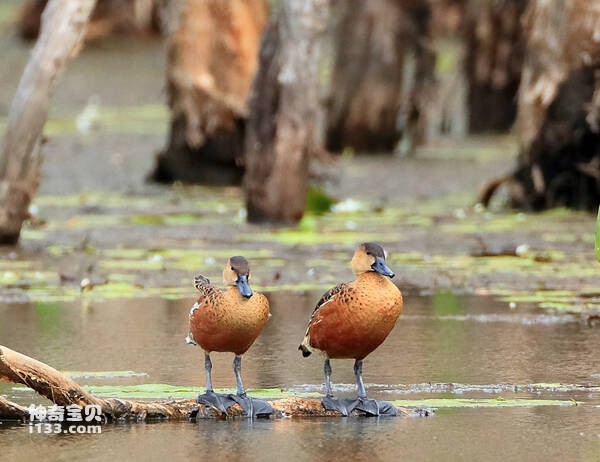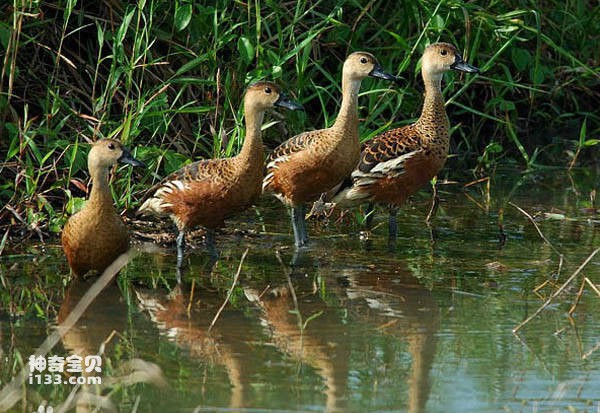Dendrocygna arcuata
IUCN
LCBasic Information
Scientific classification
- name:Dendrocygna arcuata
- Scientific Name:Dendrocygna arcuata,Wandering Whistling-duck,Wandering Whistling Duck
- Outline:Waterfowl
- Family:
Vital signs
- length:55-60CM
- Weight:About 735g
- lifetime:No textual research information is available
Feature
The sides of the head, neck, and chest show a pale yellow color, forming dark patches with the color of the front chest and neck
Distribution and Habitat
It is found in Australia, Indonesia, Papua New Guinea, Philippines, and East Timor.
Regional extinctions: Fiji, New Caledonia.
See: Singapore.
It inhabits ponds, swamps, open waters, flooded grasslands, farms, aqueducts, pastures, and irrigated rice fields. It is also found around swamps and in plant-covered ponds and streams. They prefer to hide in tall grass or under lotus leaves, and also live in groups on water, but usually avoid open lakes.
Appearance
The zebra duck is 55-60 cm long and weighs 735 grams. The top, neck and back of the adult duck are dark brown, and this color continues to the eyes. The upper body and wings are dark brown, and the back and shoulder feathers are brownish red. The appearance of this part is scaly. Primary feathers brown with dark green underside. The sides of the head, neck, and chest show a pale yellow color, forming dark patches with the color of the front chest and neck. The abdomen and sides are reddish-brown; The tail coverts are black yellow and cream. Mouth, legs and feet black gray, iris brown.
Tarsal scale peltate; The male trachea had asymmetrical bulges. The two cry different, usually different clothing and behavior; Short duration of spousal relationship and family life; Moult twice a year; The male body often changes "etched feathers" and bright wedding feathers once each; The feathers of the chicks have obvious patterns; The female has a "tease" performance.
Details
The zebra duck (Dendrocygna arcuata) has three subspecies: Wandering Whistling Duck and Wandering Whistling Duck.

When the zebra duck stops, the body is upright, and a few often look around from time to time, and take off first when people or enemies are near, followed by other trees and ducks, and the sex is extremely alert. Often in groups of a few to dozens of activities and foraging, there are many to hundreds of large groups. It is weak in flight and not as fast as other ducks. Also good at swimming and diving, and diving ability is very strong, a dive up to ten minutes. During the hot day, they often sleep and rest in the reeds or other tall water weeds. When food is abundant and undisturbed, they often inhabit fixed places and generally do not change their habitat or even migrate long distances.

The breeding capacity of the zebra duck depends on the length or short of the season, mainly depending on the amount of precipitation. It may be longer in rainy years than in dry years. The breeding season is usually from December to May in southern New Guinea and Australia, and January to May in the Philippines. Nest in grass or shrubs on the ground covered with plants. Monogamy, courtship and mating take place in the water. Before mating, the male and female ducks swim together. The male ducks continuously dip his beak towards the female, the female ducks maintain an upright position, and then the male ducks suddenly climb onto the female duck to mate. The nest is composed of grass leaves and stems, with a diameter of 25cm and a height of 6cm. Each clutch lays 7-8 eggs, up to 15 eggs, and the eggs are white. Both sexes incubate the eggs and the incubation period lasts for 30 days.
Listed on the International Union for Conservation of Nature (IUCN) 2012 Red List of Threatened Species ver 3.1 - Not Threatened (LC).
Protect wild animals and eliminate wild meat.
Maintaining ecological balance is everyone's responsibility!








